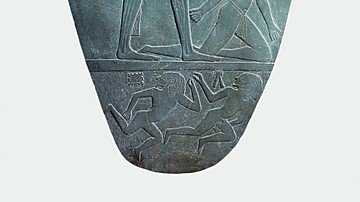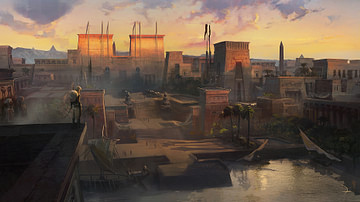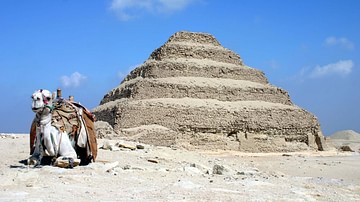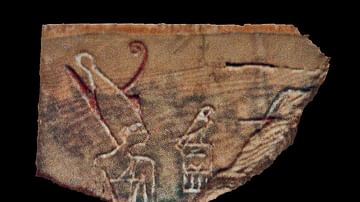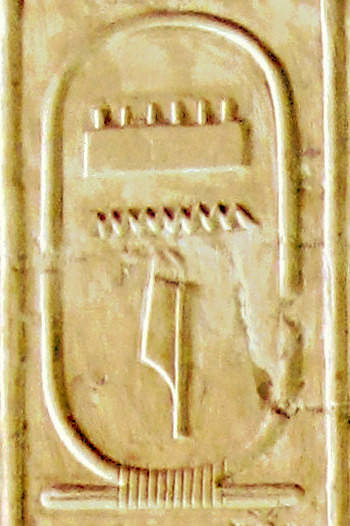
Menes (c. 3150 BCE) is the legendary first king of Egypt who is thought to have united Upper and Lower Egypt through conquest and founded both the First Dynasty and the great city of Memphis. His name is known from sources such as Manetho's Chronology (3rd century BCE), The Turin King List, and the Palermo Stone as well as from some scant archaeological evidence such as ivory engravings. In the early days of Egyptology, Menes was accepted as the first historical king based upon the written records. As time went by, however, and archaeological excavations failed to turn up any evidence of such a king, scholars began to question whether he had actually existed or was, perhaps, a composite figure drawn from the memory of the reigns of other kings.
The Egyptologist Flinders Petrie (1853-1942 CE) concluded that the name 'Menes' was actually an honorific title meaning "he who endures", not a personal name, and the first historical pharaoh of Egypt was Narmer (c. 3150 BCE) whose existence was firmly established both by the written record and archaeological evidence (most notably, the Narmer Palette, a siltstone engraving depicting Narmer's victory over Lower Egypt). In the modern day, Petrie's claim is the most widely accepted and Menes is associated with Narmer (though there are some scholars who associate the name with Narmer's son Hor-Aha). The legend of Menes, however, took on a life of its own quite independent of whatever the king Narmer may or may not have done. Narmer allegedly united the two lands of Egypt peacefully over time, married a princess to consolidate his power, and then began building projects and further developing trade with other cultures. These accomplishments, however, were not grand enough for the first king of Egypt who not only needed to be larger than life but also to symbolize a key concept in Egyptian culture: duality.
Duality in Egyptian Belief
For the Egyptians, life was a matter of balance and needed to be lived according to the principle of ma'at (harmony). This belief permeated every aspect of Egyptian culture including the office of the king. Manetho's Chronology begins by listing the many gods who ruled Egypt before Menes and, when it reaches the first king, makes clear that this man balanced Egypt by conquering the forces of chaos and presiding over a land of order. Whether this actually happened was not as important as what it symbolized. The scholars Oakes and Gahlin comment on this, writing:
The crux of the ancient Egyptian system of beliefs was the relationship between order (ma'at) and chaos (isfet). Although a state of order was considered to be the ideal, it was acknowledged that an opposing yet interdependent state of chaos must exist in order for equilibrium to be achieved (336).
The story of Menes' unification of Egypt is considered a symbolic representation of this duality so central to Egyptian culture. Prior to Menes there was conflict between the city states of Upper and Lower Egypt resulting in chaos; then came the great king who brought order and, from that order, prosperity. It was understood that chaos could come again, however, and so the king needed to be vigilant and, just as importantly, had to be a mighty warrior who could subdue the forces of chaos when the need arose. Oakes and Gahlin note:
The conventions of Egyptian art were perfect for illustrating the concept of duality, because symmetry was frequently used to create a balanced design. This is best exemplified by the artistic representation of the fundamentally important idea of the 'Unification of the Two Lands' (sema tawy). The ancient Egyptians viewed their country as consisting of two distinct parts: Upper Egypt (Shemau) and Lower Egypt (Ta-Mehu). These correspond to the South (the Nile Valley from the first cataract north to just south of Memphis) and the North (the Delta), respectively. The people believed that the origins of the state of Egypt could be traced to an act of unification of these two regions by a ruler named Menes (for whom there is no archaeological evidence) at the beginning of the early Dynastic Period (336).
Menes is said to have united the two lands through conquest and, afterwards, instituted policies which brought peace and order. As noted, it is now thought that Narmer was responsible for these advances and 'Menes' was his honorific; but whatever facts on Narmer's reign were available to the early historians, they were discarded or embellished upon to create the legend of the great king Menes.
Menes: The Legend
Menes came from the city of Hierkonpolis (though it is also claimed he came from Thinis) and conquered the neighboring cities of Upper Egypt, Thinis and Naqada, before embarking on the campaign to subdue lower Egypt. Manetho credits him with expanding the borders of his kingdom by marching across the frontiers, bringing order out of chaos. He was a great warrior but also highly cultured and later writers (such as the Roman historian Pliny) claimed he invented written script.
Once Egypt was unified and at peace, he instituted religious practices and formalized beliefs. His reign was so prosperous (lasting 62 years) that the Egyptians did not have to work as hard as they used to and developed hobbies such as carving, sculpting, sports, brewing beer, cultivating private gardens and living in luxury. In fact, the later writer Diodorus Siculus claims Menes invented the concept of luxury.
He rode on the back of a crocodile to escape rabid hunting dogs (founding the city of Crocodilopolis), founded the great city of Memphis, and established his capital there. According to Herodotus, he built Memphis after constructing a dam on the Nile to divert water away from the chosen site of his city and created his great palace and administrative buildings on land which had been under water (which accounted for the fertility of the surrounding plains). He instituted the practice of sacrificing to the gods and ensured that harmony was observed throughout the land. After a long and prosperous reign, he was carried off (or killed) by a hippopotamus.
It is not surprising that a hippopotamus should feature in Menes' end. The hippopotamus in Egyptian culture was a fearsome creature who was regularly hunted and killed and death by hippopotamus was considered among the worst. Further, the animal was associated with the god of chaos, Set, the first murderer who had killed his brother Osiris and been defeated by Osiris' son Horus. In keeping with the principle of duality, however, Set had a consort, Taweret, pictured as a woman with the head of a hippopotamus who was considered a protector. The dual nature of these two entwined gods was derived from the Egyptians' observations of the hippopotamus: the females protected and nurtured their young while the males were more aggressive and destructive.
Menes' death by hippopotamus could have been interpreted by an audience as meaning chaos had come and carried him away and, if such a thing could happen to so great a king, it could happen to anyone; people, therefore, should remain vigilant at all times. Tawaret was not associated with universal protection but only of mothers and children so it is unlikely that Menes' death would have been seen as a protective gesture by the gods who took him from earth at the appropriate time; but the association of the hippo with protection may have encouraged such an interpretation.
Menes: The History
However Menes' death was viewed, his reign was considered a kind of golden age for Egypt when life was good and the land prosperous. The scholar Douglas J. Brewer writes:
These written accounts of Menes' accomplishments, however, date thousands of years after his death, by which time he had been transformed into a cult hero whose life and accomplishments were embellished with semi-mythical anecdotes (126).
The actual king who most probably united the two lands of Egypt was Narmer who was almost certainly from the city of Thinis. Narmer established himself as supreme king of Upper and Lower Egypt and married the princess Neithhotep of Naqada in an alliance to strengthen ties between the two cities. Although he is thought to have united Egypt peacefully, there is evidence he did so through military conquest. The Narmer Palette clearly depicts this king subduing Lower Egypt by force; though whether the inscriptions on the palette should be read as history or symbollically continues to be debated. Even so, he most likely led military expeditions through lower Egypt to put down rebellions and, as with the Menes' legend, crossed the frontiers and expanded his territory into Canaan and Nubia. He initiated large building projects and the small cities of the Predynastic Period of Egypt grew in size and scope.
Narmer would not have instituted religious practice but most likely formalized it. He certainly is responsible for the buildings dated to his time which, like all those that followed, expressed the religious beliefs of the Egyptians through their architecture. When Narmer was born or how he died is unknown but it is quite clear that such a king existed whereas the same cannot be said for Menes. Brewer writes:
Menes probably never existed, at least as the individual responsible for all the attributed feats. Rather he is most likely a compilation of real-life individuals whose deeds were recorded through oral tradition and identified as the work of a single person, thereby creating a central hero figure for Egypt's unification. Like the personalities of the Bible, Menes was part fiction, part truth, and the years have masked the borderline, creating a legend of unification (142).
Unification of Egypt, whether completed or only initiated by Narmer, was probably a slow process which took many years. The turmoil evident during the Second Dynasty (c. 2980 - c. 2670 BCE) supports the claim that unification was not accomplished in a single stroke by one king. Egyptian culture, however, needed the legend of Menes and the unification of Egypt in order to establish a connection between the first king and the enduring concept of duality. Oakes and Gahlin write:
This particular aspect of the notion of duality manifested itself very clearly in the royal titles. The king's chief titles were 'Lord of the Two Lands' (Neb Tawy) and 'King of Upper and Lower Egypt' (Nesw Bity)...The regalia of kingship also reflected the idea of duality. The king might be depicted wearing the white crown associated with Upper Egypt, the Red Crown of Lower Egypt, or sometimes the Double Crown which incorporated the crowns of both regions. So north and south were distinct but both were necessary to create a whole (337).
The legend of Menes served to symbolize that whole. A great king capable of amazing feats who established a harmonious golden age at the beginning of recorded history was far more meaningful to later generations than a mere man who may or may not have unified the country. Like any founder of a nation throughout history, Menes served as an ideal of the culture's values and what it aspired to. Whether an actual man named Menes existed was irrelevant; what mattered was what his story meant to the people of his country.

![Narmer Palette [Two Sides]](https://www.worldhistory.org/img/r/p/500x600/4412.jpg?v=1746123666-1721384182)

